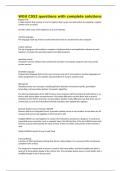Exam (elaborations)
WGU C952 questions with complete solutions
- Course
- Institution
WGU C952 questions with complete solutions Register File A state element that consists of a set of registers that can be read and written by supplying a register number to be accessed. provides 1024 scalar 32-bit registers for up to 64 threads. machine language The language made up of bi...
[Show more]



